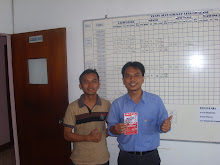Translation ( A Summary)
In his article ‘On Linguistic Aspects of Translation’, Roman Jacobson distinguishes three types of translation (Jacobson, 1959:234):
1.Intralingual translation or rewording. It is an interpretation of verbal signs by means of other signs in the same language, e.g. Paraphrasing.
2.Interlingual transltion or translation proper. It is an interpretation of verbal igns by means of some other languages, e.g. the replacement of SL(source language) into the TL(target language)
3.Intersemiotic translation or translation. It is an interpretation of verbal signs by means of sign systems, e.g. from verbal art into music, dance, cinema or painting.
Savory (1969:20-24) categorizes translation proper into four types as follows:
1.Perfect translation.
All purely informative statements, such as are encountered by the traveller or used by the advertiser. For example, at some air terminal there hang notice boards with the following messages:
IMPORTANT
Please unsure that your baggage is correct before leaving the air terminal!
ATTENTION
Messieurs les pssagers sout pries de verifier leurs begages avant de quitter I aerogare!
PERHATIAN
Silakan memeriksa barng-barang anda sebelum meninggalkan pelabuhan udara!
The three massages are not word for word identically phrased, but all contains advice of identical mneaning. You may assume that an Englishman, a Frenchman or an Indonesian takes away exactly the same impressions, and that they all usually react in the same way and possibly with the same sensations. The message is direct and unemotional and it is made in plain words to which no very intense associations are attached.
2.Adequate Translation (for mere entertainment)
Into this second ctegory fall the very large number of almost characterless translations made for the general reader who may usethem ithout giving a thought to the fact that what he is reading was not originally written in his own language, for examples English pop novels translated into Indonesian. In the process of translating from English into Indonesain the translater may omit words, or even whole sentences, which he finds obscure. He can freely paraphrase the original meaning whenever it suits him to do so. There is no reason why this should not be so, as long as the readers want nothing but the story.
3.Composite translation
This includes the translation of prose into prose, of poetry into prose, and of poetry into poetry. The translator may spend a very long timeon his work so that the commercial value of the translation is often neglected. He would only get the intellectual exercises and the keen intellectual pleasure that results from the effect.
e.g. laki-laki tua dan laut translated by Sapardi Djoko Darmono
The old man and the sea by Ernest Hemingway
4.The translated of all learned, scientific and technical matters
Scientific and technical translating has certain characteristics among others :
a.These translations are made solely because of the intrinsic importance of the original work, an importance that is strictly confined to the practical business of living. For example, R.C. Purnett’s mendelism has translated into Japanese only because the Japanese needed to know the principles of heredity.
b.The translator shall have a reasonable knowledge of the science or technique about which the original was written. This will help the translator maintain accuracy, clearness, and precision of the concepts. To translate an English lexicon disease you must have a madical background otherwise your translation will be misleading.
(Cikarang, May 28, 2009)
Minggu, 31 Mei 2009
Langganan:
Posting Komentar (Atom)








.jpg)




whould you mind to give example sir....!!!
BalasHapus